市场资讯及洞察

Most traders understand EA portfolio balance through the lens of traditional risk management — controlling position sizes, diversifying currency pairs, or limiting exposure per trade.
But in automated trading, balance is about deliberately constructing a portfolio where different strategies complement each other, measuring their collective performance, and actively managing the mix based on those measurements.
The goal is to create a “book” of EAs that can help diversify performance over time, even when individual strategies hit rough patches.
A diversified mix of EAs across timeframes and assets can, in some cases, reduce reliance on any single strategy. This approach reduces dependency on any single EA’s performance, smooths your overall equity curve, and builds resilience across changing market conditions.
It’s about running the right mix, identifying gaps in your coverage, and viewing your automated trading operation as an integrated whole rather than a collection of independent systems.
Basic Evaluation Metrics – Your Start Point
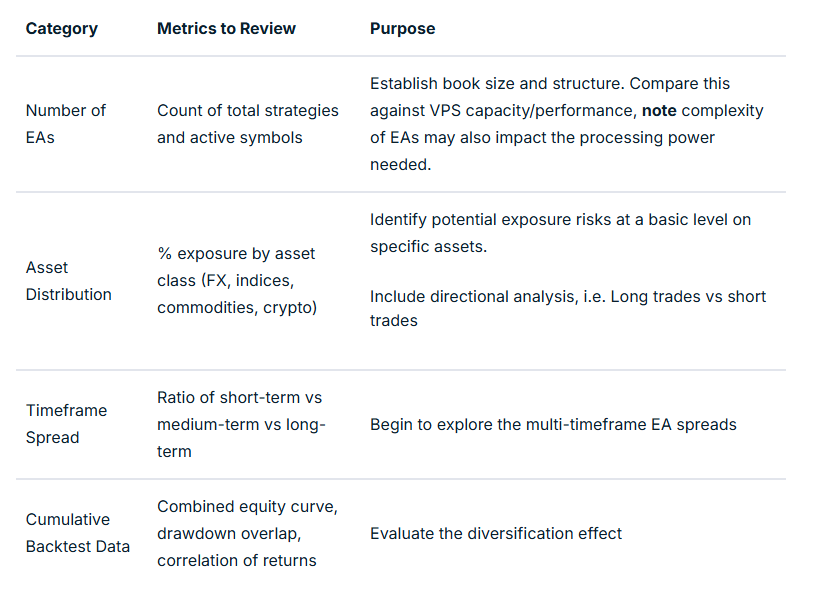
Temporal (timeframe) Balancing
When combined, a timeframe balance (even on the same model and instrument) can help flatten equity swings.
For example, a losing phase in a fast-acting M15 EA can often coincide with a profitable run in an H4 trend model.
Combining this with some market regime and sessional analysis can be beneficial.
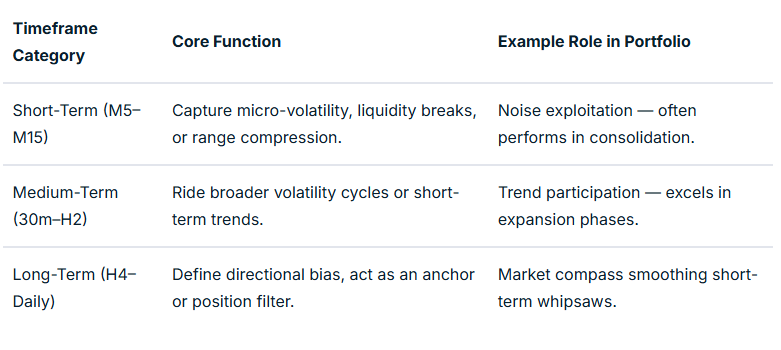
Asset Balance: Managing Systemic Correlation Risk
Running five different EAs on USDJPY might feel diversified if each uses different entry logic, even though they share the same systemic market driver.
But in an EA context, correlation measurement is not necessarily between prices, but between EA returns (equity changes) relating to specific strategies in specific market conditions.
Two EAs on the same symbol might use completely different logic and thus have near-zero correlation.
Conversely, two EAs on a different symbol may feel as though they should offer some balance, but if highly correlated in specific market conditions may not achieve your balancing aim.
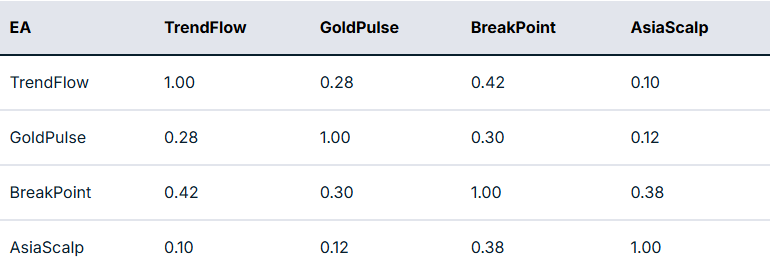
In practical terms, the next step is to take this measurement and map it to potential actionable interventions.
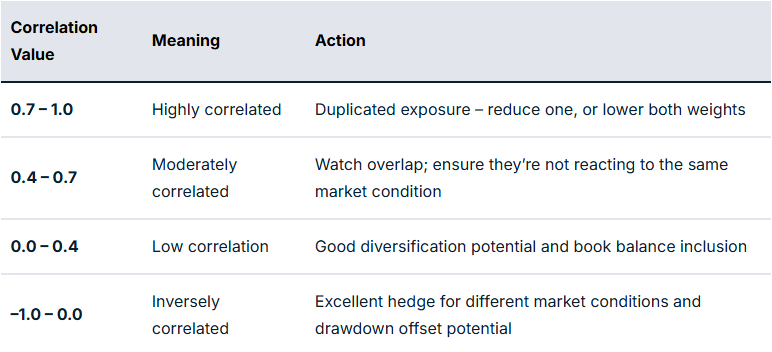
For example, if you have a EURUSD Trend EA and a GBPUSD Breakout EA with a correlation of 0.85, they are behaving like twins in performance related to specific market circumstances. And so you may want to limit exposure to some degree if you are finding that there are many relationships like this.
However, if your gold mean reversion EA correlates 0.25 compared to the rest of your book, this may offer some balance through reducing portfolio drawdown overlap.
Directional and Sentiment Balance
Markets are commonly described as risk-on or risk-off. This bias at any particular time is very likely to impact EA performance, dependent on how well balanced you are to deal with each scenario.
You may have heard the old market cliché of “up the staircase and down the elevator shaft” to describe how prices may move in alternative directions. It does appear that optimisation for each direction, rather than EAs that trade long and short, may offer better outcomes as two separate EAs rather than one catch-all.
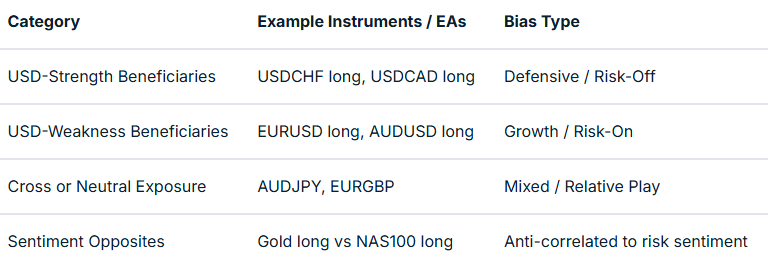
Market Regime and Volatility Balance
Trend and volatility states can have a profound impact on price action, whether as part of a discretionary or EA trading system. Much of this has a direct relationship to time of day, including the nature of individual sessions.
We have a market regime filter that incorporates trend and volatility factors in many EAs to account for this. This can be mapped and tested on a backtest and in a live environment to give evidence of strategy suitability for specific market conditions.
For example, mean reversion strategies may work well in the Asian session but less so in strongly trending markets and the higher volatility of the early part of the US session.
As part of balancing, you are asking questions as to whether you actually have EA strategies suited to different market regimes in place, or are you using these together to optimise book performance?
The table below summarises such an approach of regime vs market mapping:
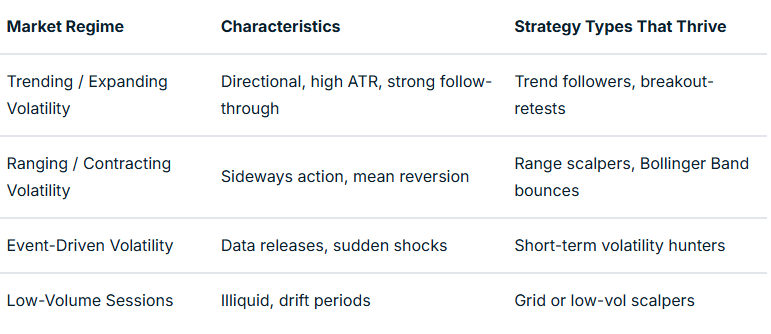
Multi-Level Analysis: From Composition to Interaction
Once your book is structured, the challenge is to turn it into something workable. An additional layer of refinement that turns theory and measurement into something meaningful in action is where any difference will be made.
This “closing the circle” is based on evidence and a true understanding of how your EAs are behaving together. It is the step that takes you to the point where automation can begin to move to the next level.
Mapping relationships with robust and detailed performance evaluation will take time to provide evidence that these are actually making a difference in meeting balancing aims.
To really excel, you should have systems in place that allow ongoing evaluation of the approaches you are using and advise of refinements that may improve things over time.
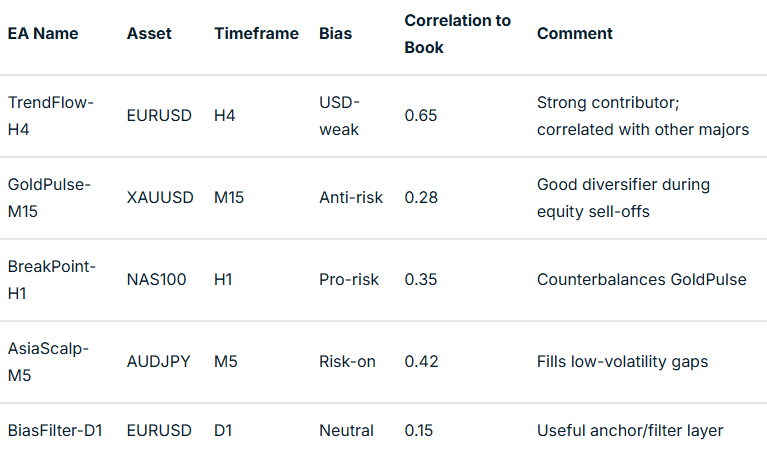
What Next? – Implementing Balance in Practice
Theory must ultimately translate into an executable EA book. A plan of action with landmarks to show progress and maintain motivation is crucial in this approach.
Defining classification tags, setting risk weights, and building monitoring dashboards are all worth consideration.
Advanced EA traders could also consider a supervisory ‘Sentinel’ EA, or ‘mothership’ approach, to enable or disable EAs dynamically based on underlying market metrics and external information integrated into EA coding decision-making.
Final Thoughts
A balanced EA portfolio is not generated by accident; it is well-thought-out, evidence-based and a continuously developing architecture. It is designed to offer improved risk management across your EA portfolio and improved trading outcomes.
Your process begins with mapping your existing strategies by number, asset, and timeframe, then expands into analysing correlations, directional bias, and volatility regimes.
When you reach the stage where one EA’s drawdown is another’s opportunity, you are no longer simply trading models but managing a system of EA systems. To finish, ask yourself the question, “Could this approach contribute to improved outcomes over time?”. If your answer is “yes,” then your mission is clear.
If you are interested in learning more about adding EAs to your trading toolbox, join the new GO EA Programme (coming soon) by contacting [email protected].


1. Inflation Uncertainty
While recent data has shown core inflation moderating, core PCE is on track to average below target at just 1.6% annualised over the past three months.Federal Reserve Chair Jerome Powell made clear that concerns about future inflation, especially from tariffs, remain top of mind.“If you just look backwards at the data, that’s what you would say… but we have to be forward-looking,” Powell said. “We expect a meaningful amount of inflation to arrive in the coming months, and we have to take that into account.”While the economy remains strong enough to buy time, policymakers are closely monitoring how tariff-related costs evolve before shifting policy. Powell also stated that without these forward-looking risks, rates would likely already be closer to the neutral rate, which is a full 100 basis points from current levels.
2. The Unemployment Rate anchor
Powell repeatedly cited the 4.2% unemployment rate during the press conference, mentioning it six times as the primary reason for keeping rates in restrictive territory. At this level, employment is ahead of the neutral rate.“The U.S. economy is in solid shape… job creation is at a healthy level,” Powell added that real wages are rising and participation remains relatively strong. He did, however, acknowledge that uncertainty around tariffs remains a constraint on future employment intentions.If not for a decline in labour force participation in May, the unemployment rate would already be closer to 4.6%. Couple this with the continuing jobless claims ticking up and hiring rates subdued, risks are building around labour market softening.
3. Autumn Meetings are Live
While avoiding firm forward guidance, Powell hinted at a timeline:“It could come quickly. It could not come quickly… We feel like the right thing to do is to be where we are… and just learn more.”This suggests the Fed will remain on hold through the July meeting, using the summer to assess incoming data, particularly whether tariffs meaningfully push inflation higher. If those effects prove limited and unemployment begins to rise, the stage could be set for a rate cut in September.


The US has entered the Israel-Iran war. However, despite an initial 4 per cent surge on the open, oil has settled where it has been since the conflict began in early June — around US$72 to US$75 a barrel.Trump claims the attacks from the US on Iranian nuclear facilities over the weekend are a very short, very tactical, one-off. This is something his base can get behind — some really big conservative players do not want a long-contracted war that sucks the US into external disputes.Whether this will be the case or not is up for debate, but there is a precedent from Trump's first presidency that we can look to. Iran had attacked several American bases in 2019, as well as attacking Saudi Arabia's most important oil refinery with Iranian drones. There wasn't a huge amount of damage; it was more a symbolic movement and display of capabilities by Iran.Initially, Trump didn't react — it took pressure from Gulf allies like the UAE and Israel for him to respond, which saw him order the assassination of the head of the Iranian Defence Force, Qasem Soleimani. This led to an Iranian response of ‘lots of noise’ and ‘cage rattling’, but minimal real action events, just a few drone attacks. Trump is betting on the same reaction now.If Iran follows the same patterns from the previous engagement, the geopolitical side of this is already at its peak.As of now, Iran is not going after or destroying major Gulf energy capabilities. Nor have there been any disruptions to the shipping traffic through the Strait of Hormuz. In fact, apart from a posturing vote to block the Strait, Iran has not made any indication that it is going to disrupt oil in any way that would lead to price surges.Additionally, despite the U.S. military equipment buildup in the region being its highest since the Iraq war, critical Iranian energy infrastructure is running largely unscathed.This all suggests that the geopolitics and the physical and futures oil markets remain disconnected. Oil will spike on news rumours, but the actual impacts in the physical realm to this point remain low. Of course, this could change in future. But, for now, the risk of seeing oil move to US$100 a barrel is still a minority case rather than the majority.


最近天下并不太平,过去几个月中东地区连续多个国家之间爆发了冲突。而过去一周以色列和伊朗互射导弹最终把美国也卷了进去。在周末的时候用B2长途奔袭,用上了15吨的地堡毁灭者给伊朗的地下设施狠狠的来了一波。相信新闻和各种视频大家都已经看过了,我就不多说了。今天咱们还是向北京出租车司机学习:赚白菜的钱,操世界和平的心。咱们来说说,这以色列和美国对伊朗动武以后,对咱们澳洲有啥影响呢?会不会导致降息被推迟呢?咱们先来说说最直接的影响:股市和油价。

在美国周末空袭伊朗核设施后,毫无意外引发中东局势紧张,伊朗直接宣布将要封锁他门前的海域。因此市场担忧霍尔木兹海峡被封锁,导致原油价格在周一开盘跳涨。今日布伦特原油上涨约2.4%至65–80 美元/桶区间波动。而在过去的3周时间,自从以色列发射导弹之后,油价已经上涨超过了20%。从62美元直接涨到了75美元一桶。按照打仗之前澳洲油价91号大约在170分澳元激素按,20%意味着91号汽油将会在2周后达到200分澳元一升以上的价格。而根据澳洲统计局的激素按,澳洲汽油每升将增加约10–12澳分,相当于普通家庭每周额外支出约5澳 。同时澳洲汽油价格每上涨1%,将会对澳洲的GDP产生0.01-0.03%的负面影响。所以如果是20%的油价上涨长期维持一段时间,将会对澳洲GDP在那一段时间里产生0.2-0.6%的负面影响。如果这个时间是3个月,那基本上,澳洲在那个季度的GDP很有可能出现负数。毕竟现在就算油价没有上涨,澳洲GDP涨幅也少得可怜。油价的上涨也将会直接导致民众手里的可用资金减少,从而增加通胀压力。那理论上来说,如果因为油价上涨20%,而导致通胀重新反弹的话,那澳洲央行是不是要重新考虑加息,或者说至少延迟降息呢?我在今年年初时判断澳洲降息会比较慢,但是后面被打脸了。但是随着现在国际局势的变化,尤其是由于中东的战争将会使得油价在未来一段时间维持在高位,这将会使得原本就增长缓慢的澳洲经济雪上加霜。澳洲央行将会再次,并持续面临一个两难的局面:压通胀,还是保经济?

其实三岁小孩都知道,澳洲的通胀只是统计局的书面数字看上去低了。但是实际百姓生活的开支最近简直疯了:我每周去超市购物,深有体会:鸡蛋:两大超市经常断货,不断货也要8澳元甚至10澳元一打。番茄:这个最近更加夸张,8澳元一公斤已经算你运气好了,墨尔本经常出现10澳元的番茄,让咱们中国人原本最普通的番茄炒蛋直接变成Fine Dining的一道菜。咖啡:普通一杯已经到了6澳元,如果加一个豆奶,碰上周末10%额外收费,直接到8澳元,就问你,一天还敢买两杯吗?车票:每天火车票已经接近10澳元一天。汽油:唯一还算可以的油价,因为伊朗的问题,将会再次回到2澳元一升的时代。咱们华人在City经常吃的午饭:兰州拉面:21澳元。越南河粉:18澳元,越南包:14澳元。沙拉盒饭:18-23澳元。

这么说吧,统计局说澳洲的通胀在过去6个月稳步下降。虽然我知道适度润色是正常的,但是这已经不是润色了,这已经是美图秀秀了吧?你告诉我,那个咱们日常生活中的商品或服务价格是在下降的?既然物价这么高,通胀明明还没有降息,为什么澳洲央行急于开始降息呢?因为相比于物价高,经济的快速降温带来的伤害更大。在过去20年里,澳洲一直坚持:政治靠美国,经济靠中国的政策,在两个大国之间灵活走位。除了有几年政府抽疯搞单边外交以外,大部分时间都基本保持着一个:身在曹营心在汉的角色。但是,由于最近曹营粮草不足,而且可能要不足相当长一段时间,直接导致了澳洲变得很尴尬。咱们从传统的矿业就可以看出,不论是必和必拓还是力拓,不论是铜铁煤油还是锂锌镍,过去12个月价格都在走低。这说明啥?这说明市场对于未来,注意,关键词:市场猜测,未来国际买家对于这些资源的需求将会减少。大家记住,股价反应的是买卖双方在此时此地,对于这个公司未来的一个预判。而不是过去,也不是现在。股价,代表的是买家对于未来的信心。同样的,澳洲的降息时间长短,其实也可以理解为澳洲央行对于澳洲经济未来的信心:如果央行对于未来有信心,那其说法就类似24年底那样:完全不用急于降息,慢慢来,反正我底子好,等的起。先把通胀完全搞定再说。

但是一旦澳洲央行判断经济冷却速度过快,那通胀就不是最紧要的问题了,咖啡番茄再贵也不是问题,经济冷了,再热就难了。所以必须加快降息。根据现在ASX RBA Tracker的数据,市场给出了超过80%以上的概率澳洲央行会在7月降息。从侧面也说明了目前金融市场同样也觉得,即使物价还在高位,也应该立即着手拉动经济了。那如果我们把以上伊朗,美国和澳洲央行这些综合情况集中到一起,可以做出一个总结:美国对于伊朗的空袭,引发了国际市场的担忧,而美元作为避免货币,澳元作为风险货币,将会在未来一段时间走出截然相反的走势。油价的上涨会伤害世界各国经济,但是由于美国和俄罗斯都是产油国,因此伤害最大的是中国。澳洲伤害也不小。但是有天然气出口可以抵消一部分。澳洲央行将会面临巨大压力:油价上涨会带动物价上涨,但是另一方面经济下滑的压力越来越大,最终两害相权取其轻,澳洲央行会选择先降息保经济。一句话总结:澳洲将会面临长期的高通胀困境,而持续的高通胀,将会加速贫富差距。大家一定要问一下身边的专业理财师,或者自己做一下研究,看一下如何在高通胀环境下安排好自己的投资。在高通胀下,普通人口袋里的钱很容易就会被高物价消耗完,所以如果不提前做一些预案,那3,5年后有准备和没有准备的人差距就会很明显了。联系方式:墨尔本 03 8658 0603悉尼 02 9188 0418中国地区(中文) 400 120 8537中国地区(英文) +248 4 671 903作者:Mike Huang | GO Markets 销售总监
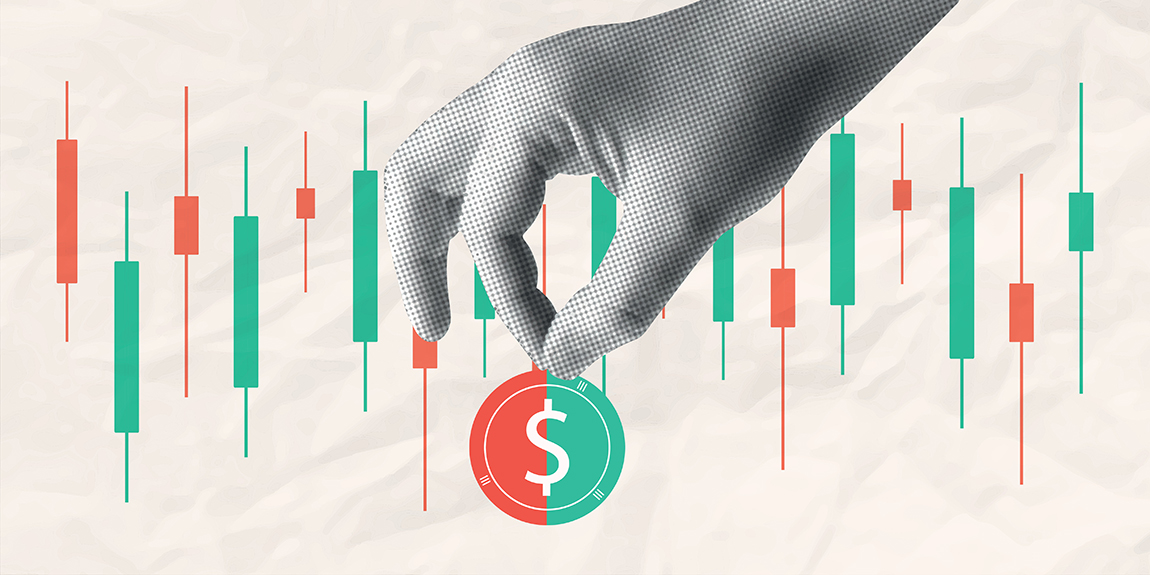

Position management is one of the most overlooked skills in trading. The shiny new entry setups seem to proliferate our social media channels, while position management receives little airplay.Yet it can be what separates a trader who rides price moves with clarity on when to take action, from one who repeatedly watches their unrealised profits simply vanish.In this article, we break down both sides of position management — scaling in and scaling out — and explore practical ways you can blend these tactics into your existing strategy.
What Are ‘Scaling In’ and ‘Scaling Out’?
Scaling in means opening your full intended position size in planned stages instead of all at once when you first see a potential set-up. This allows you to test your idea with smaller risk first, then add size as the trade proves itself. Done well, it’s like gradually moving with the “market breath” as it shows evidence of a continued move.Scaling out means taking profits off in “chunks” as the price reaches certain levels — locking in some realised profit gains rather than waiting for an all-or-nothing technical exit. Through banking gains progressively, you also reduce risk, leaving less at the mercy of the next Truth Social post or sentiment-changing event.
Why Do This?
At first glance, this may sound unnecessarily messy. Why not just get in and get out — keep it clean?Real markets rarely move in a straight line, even with the strongest of trends. Trends invariably develop in waves, and reversals can often happen quickly, irrespective of instrument or timeframe.
Benefits of Scaling In
- Risk Control: By starting small, you’re not overcommitted too early. If the setup fails, your loss is smaller.
- Confirmation: Adding when a trend continues to be confirmed helps align your exposure with demonstrated market momentum. Price action is king, and this should dictate what we do and when we do it.
- Confidence Booster: Committing in smaller steps feels less intimidating, particularly when combined with a trail or scaling-out strategy.
Benefits of Scaling Out
- Lock in Cash Flow: Taking some profit at logical points locks away real money while giving the rest of your position room to run, helping overcome any feeling of fear of missing out – FOMO — as discussed in a recent article.
- Reduces Pressure: We have all seen a big open position profit swing back. Donating your profit back to the market this way places you in a high-stress situation. Further trading decision-making may be less sharp as a result. Such stress is far less if you’ve already banked part of your profit, and you gain confidence from a good decision.
- Flexibility: You’re not forced to perfectly time the absolute high or low. You capture the ‘meat’ of the move in stages. The time when a trade is most likely not to continue in a desired direction is right at the very start of a trend, where we often see false breakouts, or near the end, where momentum is starting to drop. Why not take advantage of this?
Errors with scaling (how you can mess it up)
The potential benefits of scaling in and out are clear; however, you can still run into issues if you misuse them.Here are three scenarios where many traders may see it fail:
- Averaging Down: Adding more to losing positions, hoping to ‘get back to break-even,’ is a classic but not uncommon trap. Scaling in should always be based on the underlying concept, adding to price move strength, never to weakness.
- Random Additions: Adding size just because a trade is profitable, without clear levels or criteria for action, often backfires. It can lead to scaling at the wrong time or overdoing the next scale in lot size, as overconfidence takes over.
- No Clear Plan: Many traders who believe in the scaling out concept have every intention to do so, but in the absence of clear criteria. Having an unambiguous, specific price action-based approach is vital. Without such guidance, trading logic may be easily replaced by emotional decisions.
Like all parts of your trading, the best results are usually obtained through articulating this part of your strategy within your written plan. Constantly adjusting scale-in or scale-out points mid-trade causes overthinking and inconsistency. The whole point is to reduce second-guessing with what to do and when to do it, not add more.
Examples of ‘Scaling In’ Approaches
Example 1: Break-and-Retest approach
Scenario: A resistance level breaks decisively.Action: Enter 50% of your planned size at the breakout.Confirm: If price pulls back and holds above the broken level, add the remaining 50% on a bullish confirmation candle.Why: You get initial exposure early, but most size goes in once you have more evidence that the breakout is valid.
Example 2: Trend Building approach
Scenario: In a clear trend with identifiable pullbacks.Action: Enter the initial lot size on the setup confirmation. After a retracement pullback, add more on a breach of the recent pre-retracement swing high. Why: Rather than dumping all your capital at the first sign of pause (and there are signals which may indicate this is likely a pause rather than a reversal), you are riding the trend leg by leg, using market structure to guide your positioning.
Examples of ‘Scaling Out’ Approaches
Example 1: Predefined Profit Milestones based on risk
Example: Plan to take off 50% at 1R (one unit of risk) or an ATR multiple and trail the rest over breakevenWhy: You secure a profit cushion while letting the remaining position run for higher returns.
Example 2: Approaching Known Levels
Example: Scaling out just before major resistance levels for longs (or support levels for shorts).Why: Price often reacts to previous price consolidation levels. Taking partial profit nearby locks in gains before potential reversals. Market participants observe these levels, and there may be limit orders that may cap the likelihood of a move through the next key level.
Example 3: Weakening Momentum
Example: If you see a slowing on momentum indicators (e.g., smaller histogram bars or signal line histogram cross) or reversal candle pattern on a smaller timeframe, close a portion rather than the whole trade.Why: If you’re wrong about the trend ending, the remainder might still offer further upside benefit.
Tips for Mastering Scaling
Here are three underpinning principles to help you master scaling:
- Always plan scale points before you enter a trade — not on the fly.
- Never add to losing trades. Scale in only as confirmation builds and criteria are met.
- Journal your trading: Compare the results of trades with and without scaling to see its impact. Make this an ongoing exercise to offer some evidence to refine your initial system.
Final Thoughts
Scaling in and scaling out are not the holy grail, but if acted on well, are sharp tools for traders who want to manage trades that are in tune with the underlying market.Handled with care, they help you ride trends more smoothly, protect open position profit, and reduce the mental anguish every trader can face when the market moves unpredictably in a fully open position.The bottom line is you don’t need to catch every pip or point, just enough to make sure that you give yourself a better chance to grow your account consistently than you may be doing now.


刚刚过去的周末,市场消息面再起波澜。备受关注的热门股Circle再度拉升20%,虽然技术走势依旧强劲,但高位兑现部分利润成为不少投资者的理性选择。与此同时,恐慌指数如期上行,避险情绪显著升温,本周有望继续贡献对冲收益。地缘局势方面,中东局势再度紧张,市场传出针对伊朗核设施的空袭已展开,全球能源供应风险陡升。伊朗议会已表态支持封锁霍尔木兹海峡,若最终实施,将对全球油气运输产生深远影响。市场担忧升级,原油和黄金双双高涨,金价一度逼近3400美元关口,油价日内暴涨,恐慌指数明显抬头。美股方面,上周五三大指数普遍承压,早盘期货全线走低。尽管美联储暂未释放降息信号,但经济疲软迹象开始显现——本周将公布的GDP修正值大概率维持负数,核心PCE数据若上行也将令降息预期进一步后移。鲍威尔本周将出席国会听证,市场将紧盯其表态以判断后续政策方向。从板块看,能源、黄金、核电相关个股有望获得支撑。与此同时,加密货币市场波动剧烈,比特币周末跌破10万美元关口后迅速反弹。美元维持震荡,汇市整体波动不大,澳元、美日、美人民币汇率均保持平稳。联系方式:墨尔本 03 8658 0603悉尼 02 9188 0418中国地区(中文) 400 120 8537中国地区(英文) +248 4 671 903作者:Xavier Zhang | GO Markets 高级分析师


Have you ever stared at your charts, perfectly certain your setup is valid, then right when you are ready to press the entry button, you freeze, tweak the setup, or abandon it altogether?If so, then you have probably experienced what I call the ‘Imposter Trader Syndrome’.Irrespective of trading experience or the evidence-based nature of your trading plan, it can show up as a nagging self-doubt that makes you second-guess your method, ignore your tested plan, or jump in or out of trades for reasons you’d never put in your strategy rules.The outcome is that you move away from what you had planned to do. It eats away at both your consistency and confidence, and consequently impacts negatively on your account balance.
What Is Imposter Trader Syndrome?
Many of you will recognise the term ‘imposter syndrome’ from professional life, which is used to describe a sinking feeling that you are somehow not good enough or that you’ll be “found out” as a fraud — despite all evidence to the contrary.In a trading context, it can show up in two dangerous ways:
- Doubting your analysis and execution in both entry and exit decision-making
- Assuming good results are not attributed to knowledge and skill, but rather luck or the market gods smiling on you for a while.
Carrying these around with you may fuel indecision, constant tweaking, or abandoning your plan altogether, moving you away from consistency and confidence.
Why Does This Happen?
During many coaching hours spent with traders, there are a few common themes considered root causes of imposter trading syndrome:
1. Comparing Yourself to Others:
It is very easy to look at another trader’s highlight reel on social media (read ego-driven rambling) and assume they never hesitate or lose. You don’t see their losing trades because that is not what it is about for them. Rather, the only losing trades you will often see are just your own.
2. Recency Bias
If your last few trades were losers, it is tempting to conclude you have “lost your touch,” ignoring the fact that any system can have drawdowns. Consecutive losses within a profitable year are normal, and challenging market conditions were perhaps contributory to more difficult trading conditions. This focus on the last few rather than the big picture can result in behaviours that move away from established systems.
3. The Chase For Perfection
Many traders want a system that gives zero losses and a 100% win rate. Here is a reality check -- it does NOT exist. It is an impossible standard that can paralyse rational thinking. You may begin to fear making ‘a mistake' (any loss at all) so much that you make no decision at all. Logically, a tested system that produces positive results over time will have losses. The only mistake you can make is to move away from that system. The ability to follow it consistently, irrespective of the outcome of a single trade, should be perceived as a success.
4. Lack of Trust in Your Data
Traders often think they have a solid plan in place, but when it lacks unambiguity, hasn’t been stress-tested properly, or has only traded a handful of times in a live environment, it is difficult to develop trust in it. We know that confidence in your system is probably the number one contributor to the ability to exercise execution discipline. Unless you address this, there is a good chance that doubts will creep into your decisions more and more.
What Imposter Trader Syndrome Looks Like
Closing trades too early: Your trade has gone in your desired direction, but you don’t trust the trade to reach your planned target, so you bank profit “just in case”, only to see it hit your original profit target without you in the market.Skipping valid setups: You see the signal, but the voice says, “I have lost on the last two trades, what if I’m wrong again?” So you let it go without you and watch the price fly exactly to the set-up point you had originally planned for.Over-tweaking your plan: Constantly adding new filters, changing indicators, or modifying rules mid-week, or in the middle of a session, to “fix” something that wasn’t actually broken. I have lost count of the number of times I have seen charts with lines and colours that would look more at home in your local art gallery rather than as part of a well-thought-out trading system. Too many times, many of the things on charts either replicate another indicator, or even worse, there are things on there that the trader does not know what it is telling them at all.Revenge trading: This point is a little more ambiguous than the others, but I feel it is important to include it. Wanting to get your money back to where it was before, or trying to prove that you are a good trader when a couple of trades have gone against you, can also be a sign of imposter trader syndrome. Some suggest it can also be a form of self-sabotage, where one loss feels like proof you aren’t good enough, so you overtrade to prove yourself right.
Why Confidence Matters as Much as Analysis
More often than not, it is a failure in execution rather than a failure in system that is the cause of imposter trading syndrome. Analysis can mean very little without the confidence to follow through on it religiously. Even a flawless system fails if the trader hesitates, exits too soon, or overrides it out of fear.A consistent trading edge only works when you apply it consistently, and that takes trust in yourself as a trader and trust in your system.
The image below summarises the difference. Which trader would you like to be?
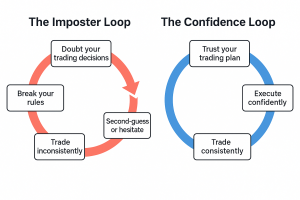
The Imposter vs Confidence Trading loop
Six Ways to Beat Imposter Trader Syndrome
1. Own it!
Until you admit that there is something amiss with what you are doing, you will never do anything to make it better. Move past the excuses and placing blame, and accept that you can do things that are in your control to move to the next level.
2. Prove It to Yourself with Data
Backtest your setup, find someone to help with this if you need to, then forward test with small positions. Keep a journal tracking whether you stuck to the plan you have invested time and effort in creating. Test out “what if” analysis of the trades you know moved away from the plan to see what would have happened if you exercised discipline in the action. Your confidence in your system will grow instantly when you see that following your rules beats not doing so.
3. Focus on Process Over Outcome
Reward yourself mentally for following the plan, not just for winning. Success in trading is usually a result of consistency in action. A well-executed loss is still a win for you in the journey towards becoming a confident, disciplined trader.
4. Use Pre-Trade and Post-Trade Checklists
A simple “Did I follow my entry rules? Did I place my stop and target correctly?” routine keeps you anchored to the process. There are lots of examples of such checklists available online, and it is a common theme covered on the education webinars we run at GO Markets.
5. Trade Smaller When Doubt is High
When moving toward where you need to be, conviction is key. Reducing size while rebuilding your trading self-esteem takes the pressure off. Better small, consistent execution than large emotional missteps in your recovery from perhaps months or even years of not achieving what you can.
6. Limit Noise
Avoid bouncing between ten different trading ‘gurus’ and strategies. Pick the lane that best resonates with your trading style and flexibility, and commit long enough to learning and refining your best-fitting system to give it a chance to see real results.
Summary
Feeling like a ‘trading imposter' is more common than most would care to admit. Unless you begin to own that it could be you, then it is likely to slowly erode your consistency and trading self-esteem. Note the signs and symptoms and commit to doing the things that build confidence in your system as well as yourself. Remember, you are not competing with other traders’ highlights, nor some of the outlandish claims of outrageous results that some may make. You are aiming to become the best trader you can be — build your own sustainable results with a system backed by evidence that fits your trading style, personal trading objectives, and financial situation.

